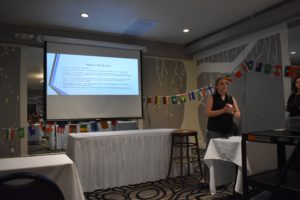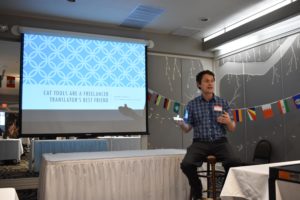Using CAT tools and prepping for the ATA exam – March 9th meeting recap

Former Board members Tony Beckwith and Monika Spindel with Marco Hanson
About 30 people turned out on Saturday, March 9th, for our second meeting of the year. After the initial announcements and introductions, President Marco Hanson paid tribute to AATIA’s previous Board of Directors with a few words of gratitude and a small token of appreciation we hope they will enjoy. He then led a brief discussion about two potential changes coming to our association: an AATIA photo badge for interested members and the possibility of AATIA becoming a chapter of the American Translators Association (ATA) (AATIA is currently an ATA “affiliated group”).

Sara Baiz
Our first presenter, Sarah Baiz, an ATA-certified translator of French and Spanish into English, gave us some general information about the ATA certification exam, highlighted some common mistakes, and offered some tips for preparing to take the exam. She stressed that the ATA certification exam is not for every translator, but if you are considering taking it, preparation is key to success. Her advice: start preparing well in advance – at least 6 months before you plan to take the exam; read a variety of texts in your source and target languages to familiarize yourself with the types of language used; take an ATA practice test in order to get feedback from an ATA grader, and then focus on improving your weaknesses; and practice on your own under the exam conditions. Sarah also emphasized the need to read all the certification-related information on the ATA website. Sarah’s slides and handout are available in the members-only section of the AATIA website.

Marco Hanson
After a brief intermission, full of wonderful snacks and fine networking, Marco gave his presentation on computer-assisted translation (CAT) tools. He started with a short back and forth with attendees to get a sense of how our group feels about these tools and what experiences users have had with them. He gave us an overview of the available brands of CAT tools, noting that currently there are more free options than when these tools first came into use. Then came demonstration time. Marco guided us through a sample translation of the Miranda rights using Word Fast Anywhere. We went through the text and saw the options for using translation memories or disabling them to type the text manually.
Marco explained that time is the most important reason why a freelance translator may choose to use CAT software, and we were able to appreciate during the demonstration how much quicker the translation goes. He also explained that the usefulness of CAT is directly related with the type of translation we do: a freelance translator who often does the same kinds of documents will save time. However, the opposite may be true for a translator whose projects don’t overlap in terms of subject matter or source. Marco’s slides are also available in the members-only section of the AATIA website.
Last, but not least, Janis Bookout from Earth Day Austin stopped by to recruit some volunteer interpreters for the Earth Day festival to be held in April. Earth Day Austin is the largest sustainability event in Central Texas, and the organizers want to help people who speak languages other than English understand the different activities that will take place during the event, hence the need for interpreters. If you are interested in volunteering, please fill in this form. If you have questions, contact Fatima Mann.
We were very grateful to have a full house and enjoyed the questions, anecdotes, and views that were shared. It’s always rewarding to come together and hear our peers’ perspectives.


Comments are closed.